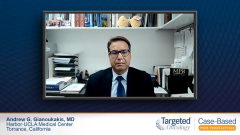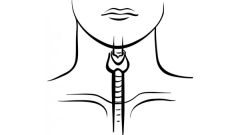
Progress in Treating RAI-Refractory DTC
Episodes in this series

Andrew G. Gianoukakis, MD: Over the last few years, it has been rewarding for those of us taking care of patients with thyroid cancer to offer something additional to patients who are radioactive iodine-refractory, no longer candidates for surgery, and are progressing. The approval of both sorafenib and lenvatinib have been game changers in that sense. However, while the drugs are efficacious, the [adverse] effects are important and often difficult to deal with, leading to dose decreases and ultimately to the drugs no longer working. Secondly, the drugs are multitargeted kinase inhibitors and hit many targets. That is what likely causes the widespread [adverse] effect profiles.
Today, we are developing more specifically targeted drugs with fewer [adverse] effects and equal efficacy. Consequently, the future is bright. Likewise, we are beginning to use these multitargeted kinase inhibitors in combination with other therapies. There is a clinical trial nearing completion combining lenvatinib with pembrolizumab, an immune checkpoint inhibitor.
Similarly, lenvatinib is being tried in the neoadjuvant setting prior to surgery in patients who are poor surgical candidates or nonsurgical candidates due to invasive disease in the neck. In the neoadjuvant setting, an attempt is made to use lenvatinib to shrink the tumor and allow for it to be resected. These are just some of the ongoing efforts we hope will lead to better care and more options for our patients with thyroid cancer. In addition to the newer agents, the more specific agents with fewer [adverse] effects and equal efficacy are either in development or have been recently approved.
Transcript edited for clarity.
Case: A 73-Year-Old Woman With Differentiated Thyroid Cancer
Initial Presentation
- A 73-year-old woman complains of a “lump” on her neck, with occasional swelling and dysphagia
- PMH: obese; BMI 32
- PE: palpable, nontender neck mass
Clinical Work-up and Initial Treatment
- Labs: TSH 1.1 µU/mL; all others WNL
- Ultrasound of the neck revealed a 3.0 cm mass in the right lobe of the thyroid; several suspicious lymph nodes ranging from 0.2-3.0 cm in size
- Ultrasound-guided FNAB: confirmed papillary thyroid carcinoma
- Patient underwent total thyroidectomy with bilateral central neck dissection
- Pathology: 3.0 cm papillary thyroid cancer arising in right lobe of the thyroid, 2 of 5 positive central compartment lymph nodes, largest 1.4 cm, positive extra nodal extension
- StageT2N1MX; ECOG PS 0
Subsequent Treatment and Follow-up
- She was treated with radioactive iodine
- Levothyroxine to suppression was added to treatment regimen
- Follow-up at 6 months TSH 0.4 µU/mL, thyroglobulin 4 ng/mL
- Neck US unremarkable
- Follow-up 12 months TSH 0.3 µU/mL, thyroglobulin 18 ng/mL
- US of the neck was unremarkable
- CT of the chest showed 10 lung nodules, largest 1.2 cm in size
- Administered radioactive iodine 150 millicuries
- Post therapy scan showed no lung or other uptake
- Follow-up at 2 years TSH 0.3 µU/mL, thyroglobulin 30 ng/mL
- Chest CT increasing number and size of lung nodules; largest 1.6 cm
- Patient was asymptomatic and deemed radioactive iodine refractory
- Systemic therapy with lenvatinib 24 mg PO qDay considered








































